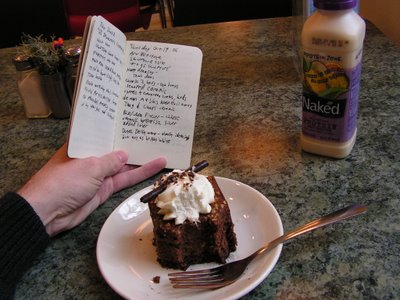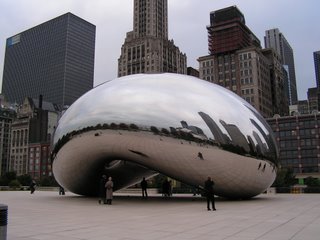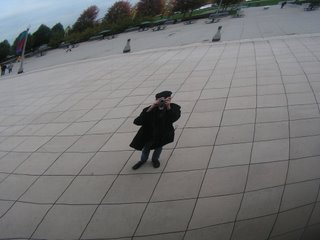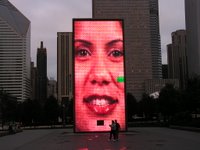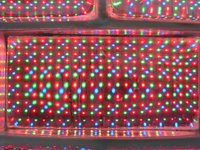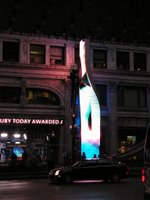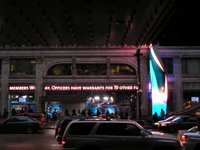I got a later start today, as I was exhausted from all the walking yesterday. Getting used to being in a big city also took a toll on me, but today was better. I took the red line to Roosevelt and walked around the Columbia College Chicago area on the south end of the loop. The neighborhood is full of urban college campuses built in to office areas, so it's not uncommon to see a college freshman with harshly dyed black hair standing next to a business man with his own grey hair dyed out.
I missed the first panel discussion after I couldn't find the building, so I went to the Art Institute. It is still one of my favorite places in the world to see art. European museums are nice for their depth, but they naturally tend to focus on their respective country. The Louvre is amazing, but there were great artists in other countries too. The Chicago Art Institute has paintings from all over the world grouped into galleries by time period and subject matter. As I followed my usual route through the European wing past several depressing crucifixion depictions (think CSI: Golgotha), I paid attention to each painting's nation of origin and overall feel. The Italian paintings throughout had more allegory (less literal, I mean), more emotion, and more romanticised flesh tones. The French were more experimental, especially during the absinthe days of the mid to late 1800's. The British aren't as well represented in this wing, but what I saw was very formal and detailed and less emotive (hanging on in quiet desperation is the English way, after all). The Spanish were pretty much rock stars- all strong emotion and muscle. See Francisco Goya's work and you'll know what I'm talking about. As I kept walking, I began to consider how the narratives in these old paintings manage to carry through to today. Some of the symbolism is lost on the average viewer, such as the meaning of certain flowers or the stature and clothing color of certain politicians, but the gestalt comes through clear as day in most cases. If these themes and narratives are that durable from an old culture to a contemporary one, that says a lot about the power of art as a visual history and shared world culture.
After I collected my coat from the coat check I set out to find some food. I happened upon the Blick art store, a huge two level toy store for creative people, where I bought a pack of three small brown notebooks. I'm too afraid to take my normal moleskine out with me for fear of losing it, or running out of pages at an inopportune moment. The new thinner notebook is easier to carry, and if I lose it I haven't lost three years worth of brickabrack dating back to my unemployment days.
A little before 6:30 I found my way to 31 E. Balbo and an unassuming entrance to the Hot House, an amazing little club/venue for progressive arts on the Columbia campus. The interior is decorated with subdued red walls and minimal lighting from electric candelabra wall lights and Fresnel lamps pointed at an elevated stage in the center of the room on the back wall, with a large mural of jazz musicians behind it. I was there to see Lorraine Ali, a senior writer at Newsweek who covers music, pop culture, and Arab-American issues. Her pedigree for these fields is equally impressive- she's written for the LA Times and Rolling Stone, interviewed the Rolling Stones (in her words, "totally terrifying"), and even voted in the 2005 Iraqi election, as her father is a citizen. She spoke about her career, trying to balance the alternative music culture in the early 90's with mainstream appeal in order to get published while not selling out. Professional integrity was definitely a theme. She read her profile on Ali G, and I had to quickly explain to the middle aged women sitting at my table who he was. A guy from the audience came up onstage to read the Sacha Baron Cohen parts in character, and everybody laughed. Then she read a profile on the subculture of stalwart Michael Jackson fans during the singer's trial. She had found people with fanatical loyalty to him to the point some acted like they knew him. The next piece was even heavier, about her remembering a Baghdad family reunion in 1976, and how she still thought about her family being caught in the chaos and economic ruin of the past decade. She has a book in the works about this and other issues, and I'll definitely look for it when it comes out. One of the best things she said all night was "if you aren't interested in things outside your beat, you aren't gong to be that interesting."
After it was over, I waited in line to ask her a question. A journalism undergrad asked me a few questions about how I liked the presentation for his assignment, and of course I answered all of his questions, as I have many friends in the fourth estate. (I neglected to ask if he was Jewish.) When it was my turn, I asked the author what she thought of music promotion through Myspace and did she think it would be possible for a band to break out this way. She said it was still early yet, but she would want to see if it happened organically or if a record label did some of the pushing. She also mentioned her feelings on blogs, saying that the mainstream press had this coming, that a group of writers would start reporting on their world and asking hard questions without fear of losing their access to celebrities.
I'm starting to get more of a handle on my immersion topic. In a city of aggressively persistent stimuli from trains, traffic, people, and signs, some narratives are able to come through clearer than others. It is my belief that the more successful narratives resonate with people, so they are not forgotten along with the pervasive storefront ads and billboards. Some narratives are even powerful enough to draw crowds in for their own sake, in the case of the Art Institute. I'll try to flesh this idea out over the course of this project.
One last thing worth mentioning- the woman who sat to the left of me at the Hot House is an art critic for Chicago Magazine. I just figured that out looking at the Columbia College website. She would have been good to talk to. D'oh.
